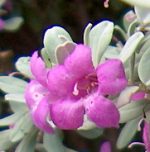 Also known as cenizo, purple sage, Texas barometer bush, and silverleaf, this compact evergreen shrub is native to open canyons, arroyos, ditches, ravines, and hillsides in Texas and northern Mexico but is also a popular ornamental plant. It is a member of the figwort family, Scrophylariaceae, that also includes Verbascum, Diascia, and Nemesia. Silver stems carry silvery leaves that are covered with stellate hairs. The leaves are up to 1.25 inches long, and have rounded tips and smooth margins. The pink to violet or purple flowers are bell-shaped, one inch long and wide, and appear singly in the leaf axils. The flowering of the shrub is said to be triggered by rainfall (hence the common name, Texas barometer bush) and occurs intermittently from spring to fall. The fruit is a small capsule. Plants are very heat and drought tolerant and a good choice for hedges, screens, windbreaks, and shrub borders or foundation planting in dry hot environments. The generic name Lecophyllum comes from the Greek words leucos meaning white and phyllo meaning leaf, referring to the silvery appearance of the leaves. The specific epithet, frutescens, is the Latin word for shrub-like.
Also known as cenizo, purple sage, Texas barometer bush, and silverleaf, this compact evergreen shrub is native to open canyons, arroyos, ditches, ravines, and hillsides in Texas and northern Mexico but is also a popular ornamental plant. It is a member of the figwort family, Scrophylariaceae, that also includes Verbascum, Diascia, and Nemesia. Silver stems carry silvery leaves that are covered with stellate hairs. The leaves are up to 1.25 inches long, and have rounded tips and smooth margins. The pink to violet or purple flowers are bell-shaped, one inch long and wide, and appear singly in the leaf axils. The flowering of the shrub is said to be triggered by rainfall (hence the common name, Texas barometer bush) and occurs intermittently from spring to fall. The fruit is a small capsule. Plants are very heat and drought tolerant and a good choice for hedges, screens, windbreaks, and shrub borders or foundation planting in dry hot environments. The generic name Lecophyllum comes from the Greek words leucos meaning white and phyllo meaning leaf, referring to the silvery appearance of the leaves. The specific epithet, frutescens, is the Latin word for shrub-like.
Type: Evergreen flowering shrub
Outstanding Feature: Flowers; winter interest
Form: Arching to rounded crown
Growth Rate: Rapid
Bloom: Pink to violet or purple bell shaped flowers one inch long and wide, singly in the leaf axils intermittently from spring to fall
Size: 5-8’ H x 4-6’ W
Light: Full sun
Soil: Average, dry to medium moist, very well drained, alkaline
Hardiness: Zones 8-10
Care: Plants tend to become rangy in the garden from too much water and fertilizer so should be hard pruned to control size and shape or tip prune to encourage compactness. Do NOT fertilize!
Pests and Diseases: None of significance although cotton root rot can be a problem if plants are over-watered.
Propagation: Seeds, semi-hardwood cuttings , softwood cuttings
Comments: Popular cultivars include ‘Green Cloud’, ‘White Cloud’, ‘Compacta’, ‘Convent’, and ‘Bert-Star’.